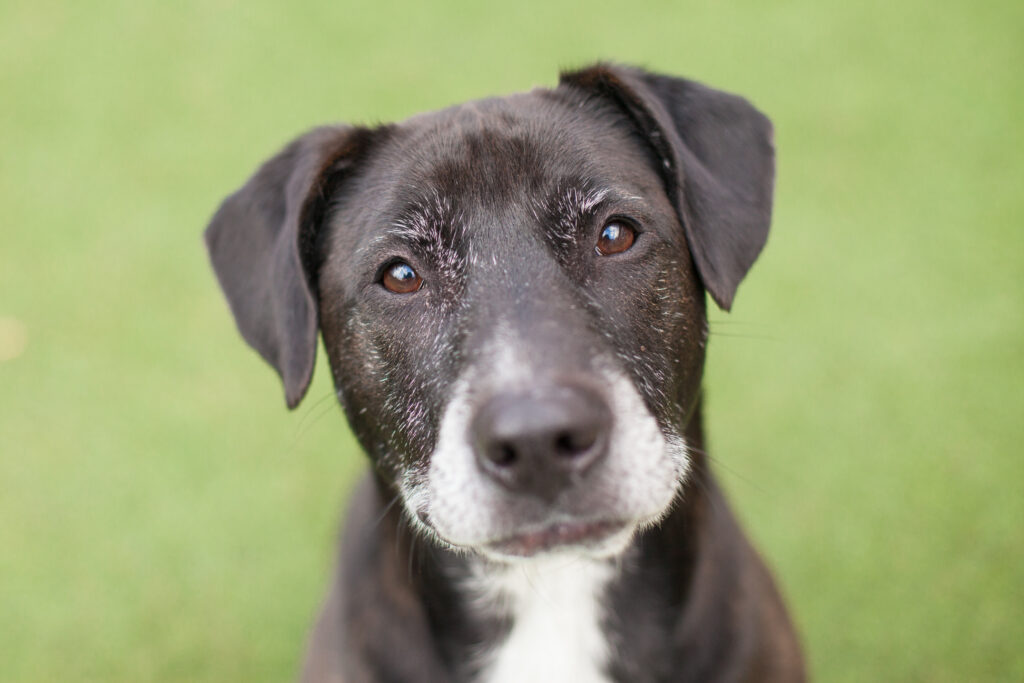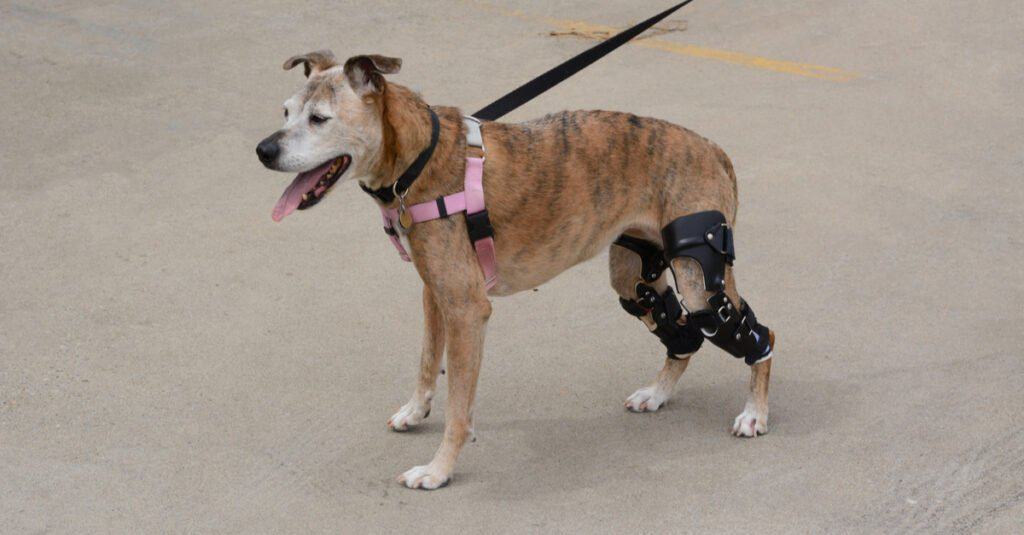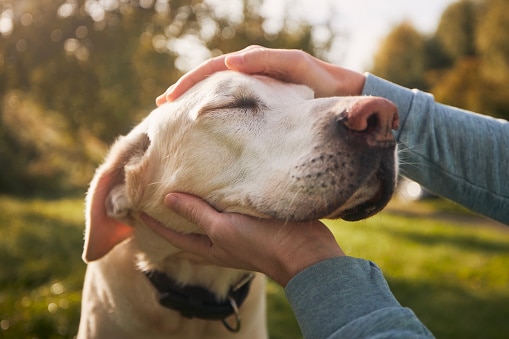If you are a pet owner of a senior dog, you may have some worries about things that may happen as they age. One of the things that can happen in senior dogs is the onset of hind leg weakness. If your dog is already experiencing this, you likely have questions about what causes it or what you can do to treat it. And if your dog hasn’t experienced this, luckily there are ways you can prevent it. Read on to learn more about hind leg weakness in senior dogs and what you can do about it.

One of the things that can happen in senior dogs is the onset of hind leg weakness.
©Tara Lynn and Co/Shutterstock.com
What Causes Hind Leg Weakness in Senior Dogs?
Sometimes hind leg weakness can come on suddenly without warning in senior dogs. There are a variety of things that could cause this to happen, so it’s important to take a look at your dog’s overall health to determine the cause. Let’s take a look at some of the health issues that could lead to the weakening of your dog’s hind legs:
Diabetes
If your dog suffers from diabetes, it can cause your dog’s hind legs to weaken over time. This is because diabetes has an impact on your dog’s leg joints which can cause its legs to weaken. When this happens, it also impacts your dog’s ability to produce enough insulin which means your dog may experience very high blood sugar levels.
Symptoms of diabetes in dogs include extreme thirst and increased hunger levels. With weakening hind legs, your dog may also experience incontinence and weight loss. If you’re concerned that diabetes is the cause of hind leg weakness in your dog, your veterinarian can take blood samples from your dog and inform you on whether or not diabetes is the primary cause of it.
Diagnose and treat diabetes promptly, as very high or low blood sugar levels can be dangerous. The sooner your dog receives a diagnosis, the sooner treatment can begin, which may slow or improve the weakening of your dog’s legs.

Symptoms of diabetes in dogs include extreme thirst and increased hunger levels.
©alexei_tm/Shutterstock.com
Arthritis
Dogs can develop arthritis just like humans can, and conditions like osteoarthritis can have an effect on the strength of your dog’s hind legs. This type of arthritis is the kind that affects your dog’s body’s ability to lubricate its joints properly. This can mean a great deal of pain for your dog whenever it moves or walks. Over time, this lack of lubrication in its joints can result in the weakening of its hind legs as it becomes more and more painful to walk.
If you notice that your dog is having difficulty doing things like climbing the stairs, or jumping, or its front legs becoming stronger while the hind legs weaken, you may want to get your dog to the vet to determine if arthritis is the cause.

Knee braces can help with ACL/CCL injuries, sprains, arthritis, and more.
©Merrimon Crawford/Shutterstock.com
Canine Degenerative Myelopathy
This condition is where the sheath that normally protects your dog’s nerves breaks down and exposes the nerve. When this happens, the dog’s nerves are not working as they are suppose to and its hind legs quiver. In some cases, you may notice that your dog’s hind legs come together while standing, or are in a strange position. Canine degenerative myelopathy is a spinal condition that can affect almost any dog breed, however, it tends to be more common in Boxers, Rhodesian Ridgebacks, German Shepherds, and Cardigan Welsh Corgis.
If you notice that your dog’s hind legs are quivering when it stands or its feet are in unusual positions, have your dog seen by a vet. They will determine if this condition is the cause, and begin a treatment plan to deal with the pain and discomfort.

If you notice that your dog’s hind legs are quivering when it stands or its feet are in unusual positions, have your dog seen by a vet.
©Ermolaev Alexander/Shutterstock.com
Hip Dysplasia
A dog’s hip joints become loose creating hind leg weakness.. If this is the case, then it’s likely that your dog has hip dysplasia. One sign of this is your dog losing its balance while standing or walking.
Hip dysplasia can sometimes lead to osteoarthritis. This is a more common diagnosis in larger dog breeds like Saint Bernards, Labrador Retrievers, German Shepherds, and Great Danes. Hip Dysplasia is mostly caused by genetics but a dog can also develop it depending on its size, weight, and the overuse of its hips or legs.

Hip Dysplasia is mostly caused by genetics but a dog can also develop it depending on its size, weight, and the overuse of its hips or legs.
©Kuznetsov Alexey/Shutterstock.com
What Are Some Ways to Keep a Dog’s Hind Legs Strong?
The good news is that there are many simple ways to help keep a dog’s hind legs and the bones throughout its entire body strong. Let’s go over some of the ways you can keep your dog’s bones strong and reduce the chances of it developing hind leg weakness:
Make Sure Your Dog Gets Enough Exercise
It’s very important to keep your dog moving and active if you want to keep its muscles and legs strong. Taking your dog out for regular walks can help keep its leg muscles strong and reduce the chances of them weakening. However, even good things should be done in moderation, as having your dog excessively use its leg muscles can do more harm than good. Short, regular walks are better than taking your dog on long strenuous walks. You can also try letting your dog go swimming, as this is much easier on its joints (which is especially helpful for senior dogs).
If your dog is not strong enough to go for a walk, definitely do not force it. You may be able to help its legs by giving them a gentle stretch. Manually stretching your dog’s legs (very gently) can help relieve pain and keep its muscles from being too sore if it is unable to go out for walks. It may also be recommended that you have your dog wear a leg brace to help it tolerate going for walks easier or just for general wear around the home.

Taking your dog out for regular walks can help keep its leg muscles strong and reduce the chances of them weakening.
©a katz/Shutterstock.com
Make Sure Your Dog Has Nutritious Food
Protein is a very important part of a dog’s diet and can help keep your dog’s hind legs strong. Having the right amount of protein in a dog’s diet will help its bones grow strong and healthy and reduce the chances of it developing hind leg weakness in its later years.
Try including foods like beef, tuna, chicken, and milk along with a good quality high-protein dog food to add a boost of protein and nutrition. Dogs can also benefit from some plant-based sources of protein as well like potatoes, pumpkin seeds, etc. Just be sure that you are including healthy animal-based sources of protein in your dog’s food, as these are vital to its health.
If your dog is not getting enough protein in its diet, it limits the amount of calcium the body is able to absorb which leads to weakened bones. Healthy food will also keep your dog at a healthy weight. If your dog is overweight, there will be more pressure on its joints which would make moving and walking more difficult. The additional pressure on its joints could cause them to weaken over time, resulting in weak hind legs and overall joint pain.

Protein is a very important part of a dog’s diet and can help keep your dog’s hind legs strong.
©stockcreations/Shutterstock.com
Try Giving Your Dog Supplements
In addition to a healthy diet, you can also try introducing supplements. Making sure your dog has the right amount of vitamins and minerals in its diet will help it have the best opportunity for optimum health and reduce the chances of suffering hind leg weakness. Some good nutrients that help keep a dog’s bones healthy include vitamins K, D, C, E, and magnesium.
There are also specific supplements that can help target your dog’s bones and joints and make them stronger:
- Collagen: This helps keep your dog’s bones and joints healthy and lubricated
- Glucosamine: Can reduce joint pain and prevent further damage
- Fish oil: This contains high amounts of omega-3 which is a nutrient that can help reduce inflammation and help improve your dog’s mobility and reduce pain
- Chondroitin: This supplement can help reduce inflammation and pain in achy joints
Making sure your dog gets plenty of gentle exercise and has the right food and nutrients can greatly improve your dog’s mobility and reduce or prevent hind leg weakness. Once incorporating these things, you may notice that your dog’s legs become stronger and it is able to move with better ease. If you have any further questions or concerns about your dog’s bone and joint health, it is always best to get in touch with your vet and have them seen by a professional for treatment.
Bonus: What Changes Should I Expect as My Dog Becomes a Senior?

Aging affects dogs as it does people.
©Chalabala/ via Getty Images
It almost seems to happen overnight – your always energetic dog suddenly wants to end walks sooner or can’t leap up on the sofa with ease. She may stand still with confusion or stop walking with a happy, jaunty trot. Your beloved pet has become a senior citizen and like her human counterparts – she deserves respect, love, and a few concessions. Here are some things to expect of your senior dog:
- Thinning or whitening fur – especially around the face
- Reduced activity and mobility
- Weight changes – gaining or losing
- Susceptibility to temperature – trouble staying cool in summer or warm in winter
- Loss of hearing and vision – cataracts are common in senior dogs
- Behavior changes – caused by pain or cognitive decline
- Dental issues such as periodontal disease
You can make your dog’s golden years easy and comfortable by watching for any signs of pain or decline and by getting regular check-ups from your vet. Make adjustments as necessary – such as helping your pet onto your lap when they can’t jump – or carrying him up the stairs. Continue taking your senior pet on walks but adjust the length and pace. Food may need to be changed, and medications added – as well as a gentle touch and extra love and affection.
The photo featured at the top of this post is © MirasWonderland/Shutterstock.com
Ready to discover the top 10 cutest dog breeds in the entire world?
How about the fastest dogs, the largest dogs and those that are -- quite frankly -- just the kindest dogs on the planet? Each day, AZ Animals sends out lists just like this to our thousands of email subscribers. And the best part? It's FREE. Join today by entering your email below.
Sources
- TPLO Info, Available here: https://tploinfo.com/blog/how-to-prevent-hind-leg-weakness-in-senior-dogs/
- The People's Dispensary for Sick Animals, Available here: https://www.pdsa.org.uk/pet-help-and-advice/pet-health-hub/conditions/degenerative-myelopathy-dm-in-dogs
FAQs (Frequently Asked Questions)
What are reasons to cause hind leg weakness in dogs?
Dogs can begin to experience hind leg weakness due to diabetes, arthritis, canine degenerative myleopathy, and hip dysplasia.
What are ways to prevent hind leg weakness in dogs?
Exercise, healthy food options and supplements are ways to help prevent leg weakness in dogs.
Thank you for reading! Have some feedback for us? Contact the AZ Animals editorial team.






